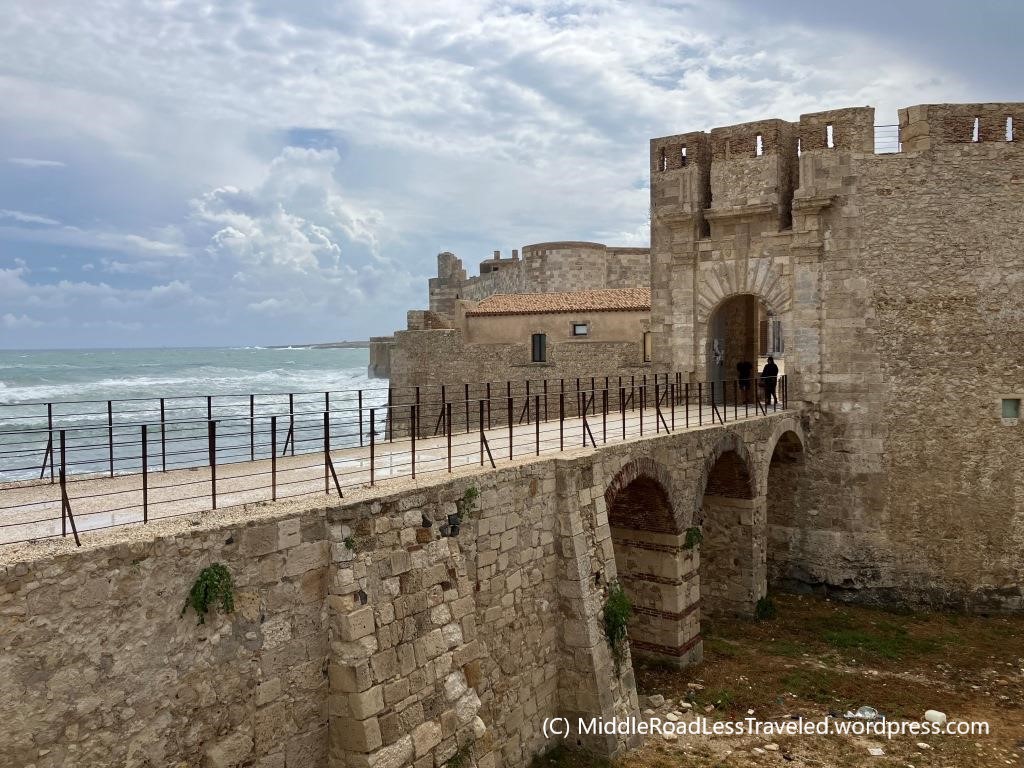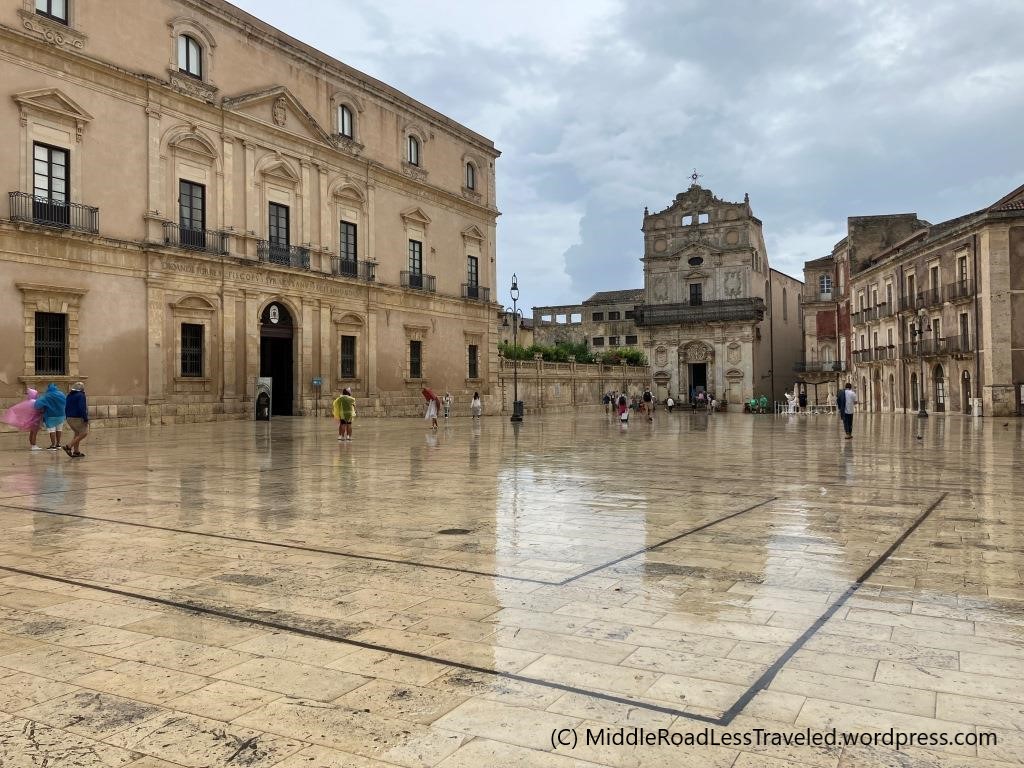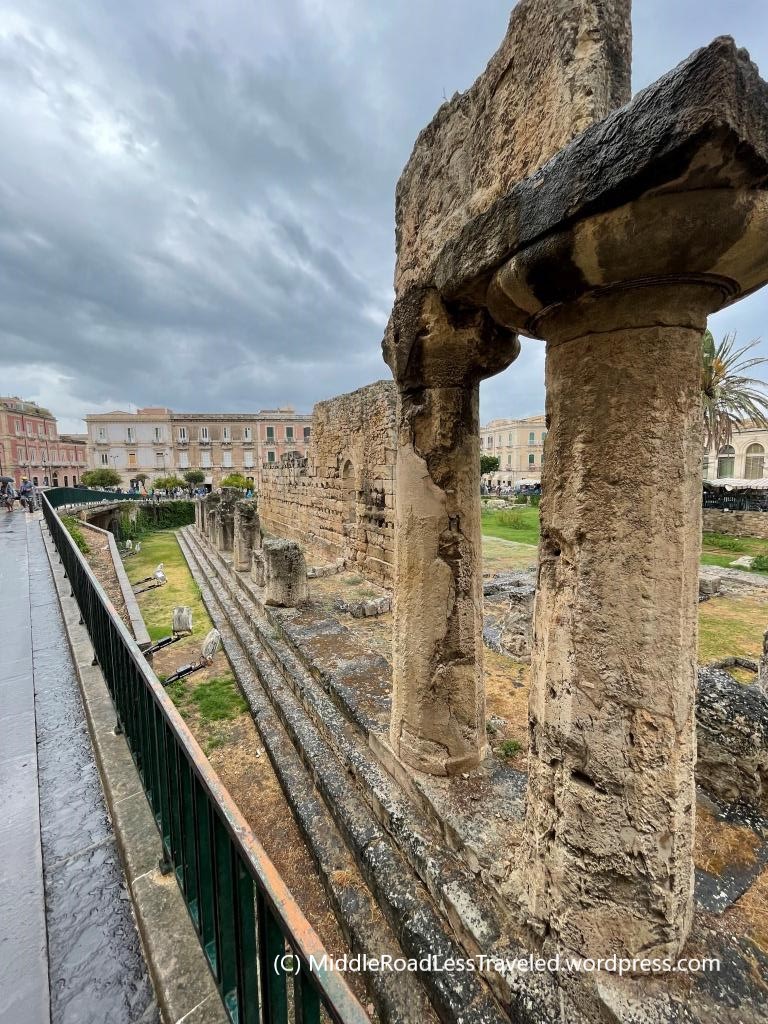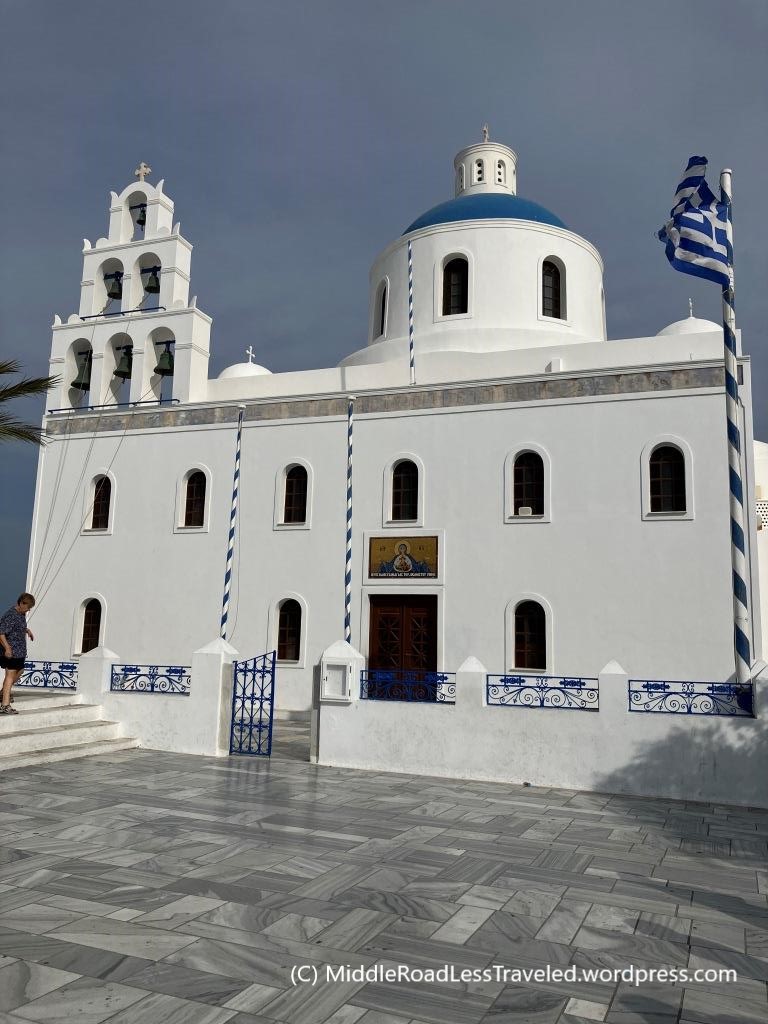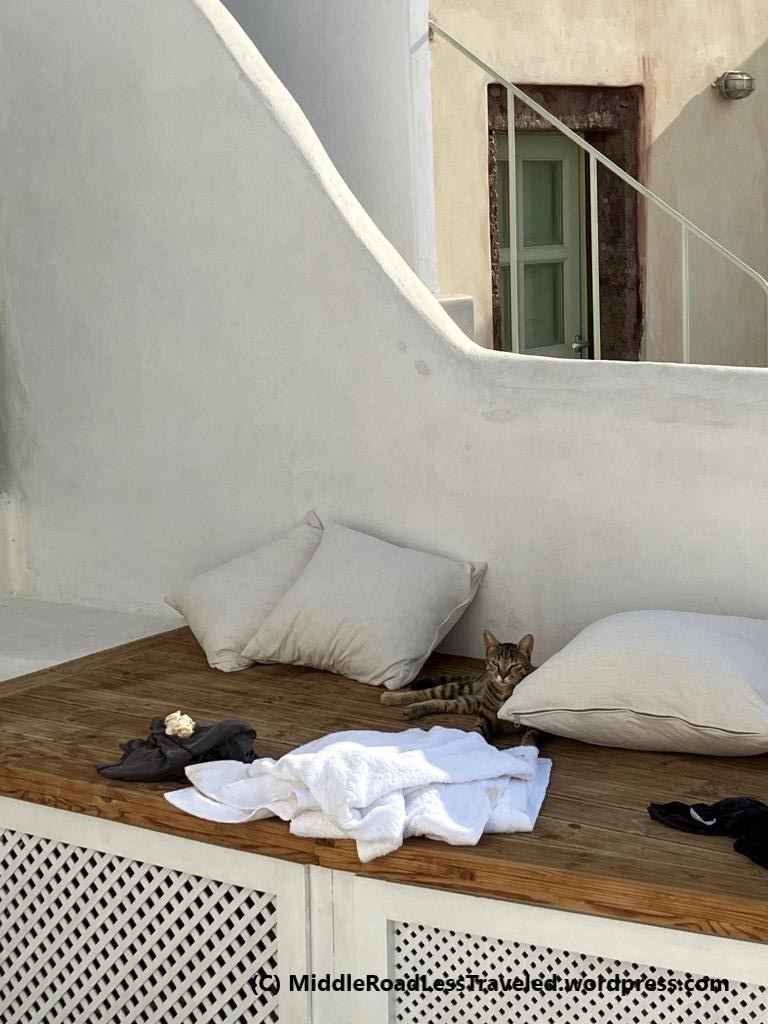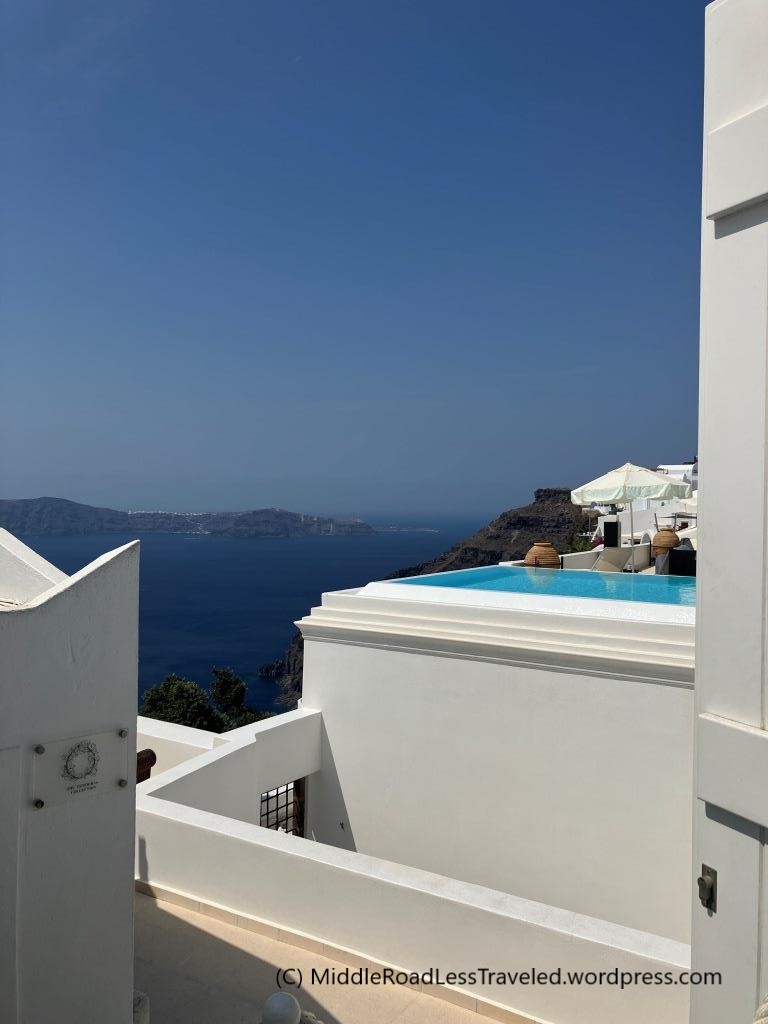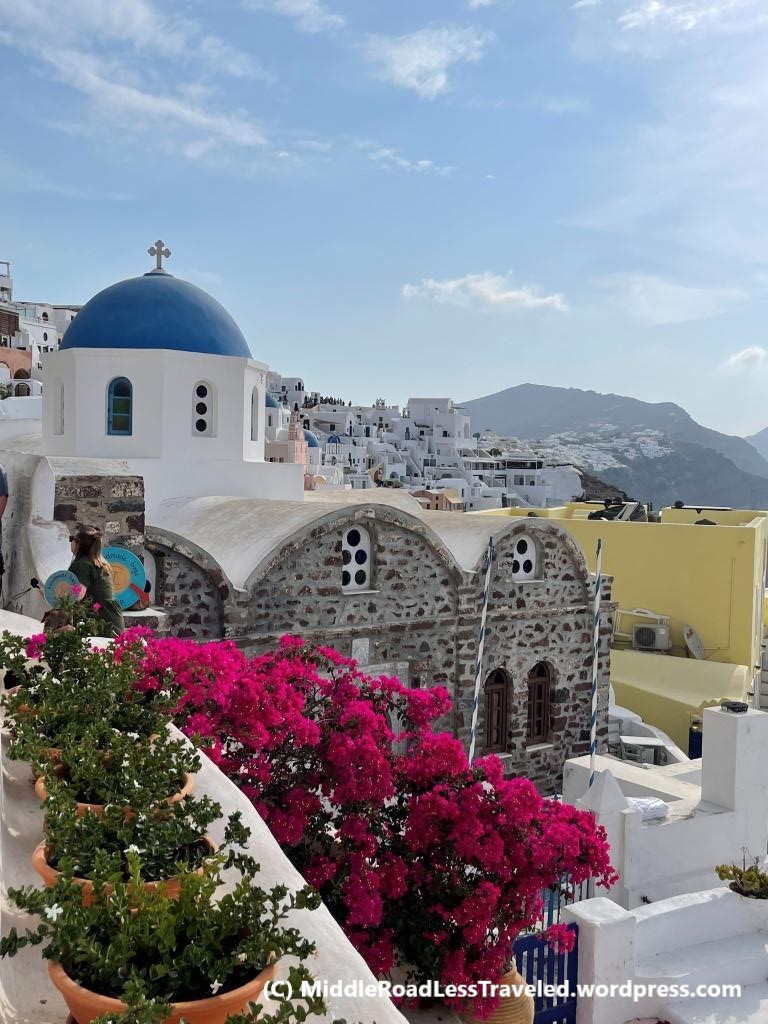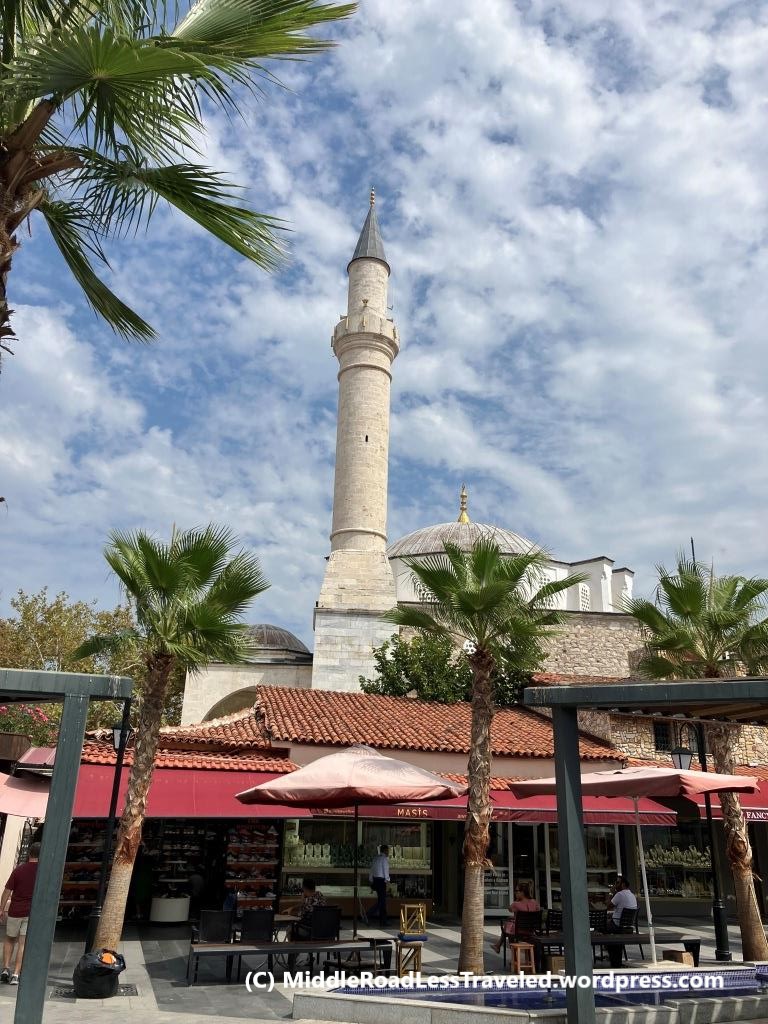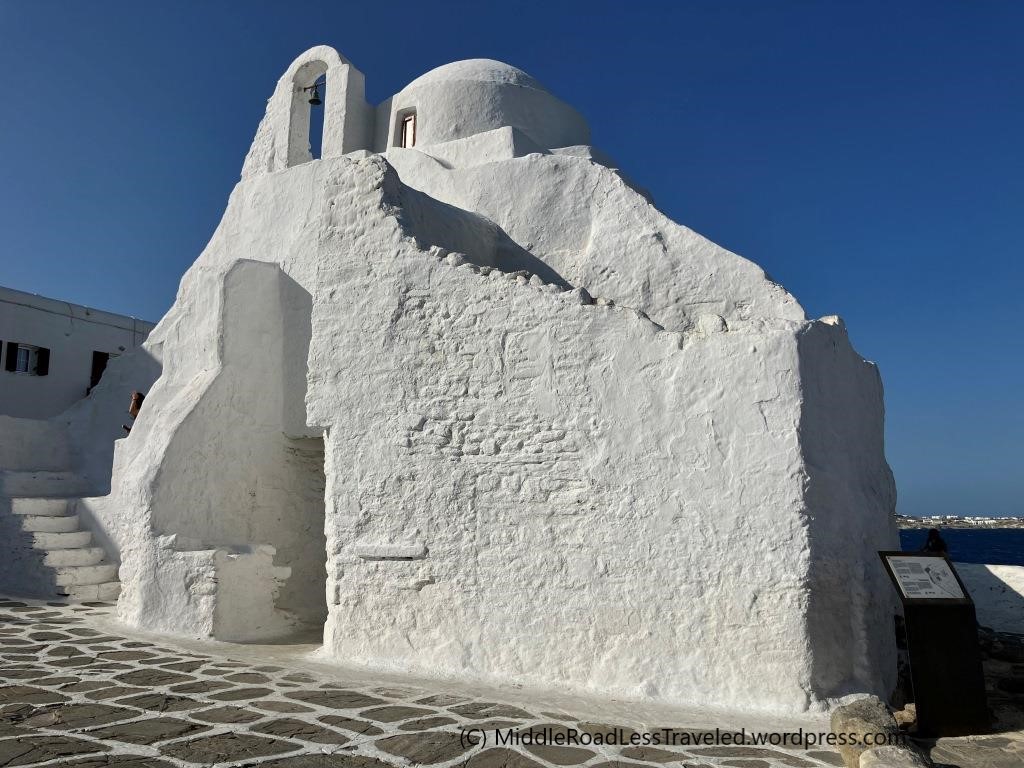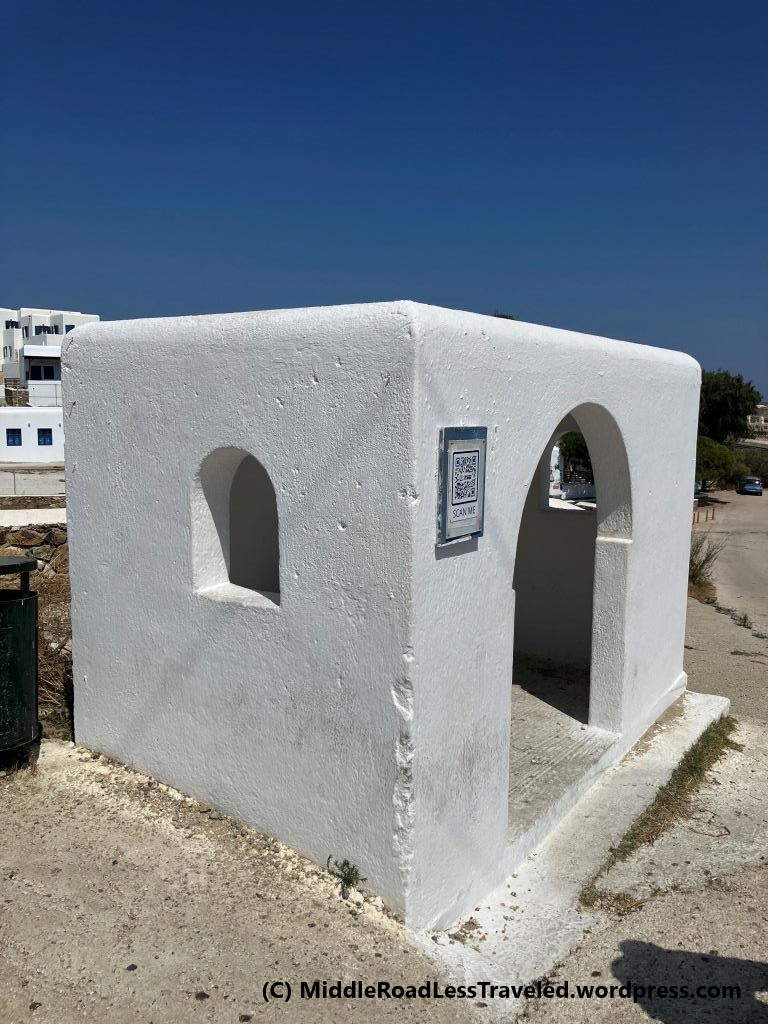This is part 2 of our long-awaited European trip. Part 1 was Rome and Part 3 was Athens Greece.
Notes: I provided optional links in this article if the reader would like more information. I’m not affiliated with any of these sites nor can I confirm their validity. Also, all images below are low resolution for obvious reasons.
Cruise Day 1
Salerno, near the Amalfi coast, was the first stop on our cruise. This gave us access to the legendary city of Pompeii.
Salerno is 40 minutes southeast of the city of Naples. We had signed-up for a tour of Pompeii since we thought we would need some ‘guidance’ to explore this large, ancient site. We took the first tour in the morning, along with many other tour companies who were also giving their first tour of the day.
However, the tour we took was lackluster. We had audio receivers with a single wired “earbud” so that we could hear our guide when he spoke through his microphone. In hindsight, we should have made this a self-guided tour. There are modern signs with numbers everywhere in Pompeii so that you can sync online information with a self-guided tour. We saw several tourists taking self-guided tours with their phones.
Pompeii itself was amazing. Walking along the same streets and sidewalks that ancient Romans once walked was incredible. Pompeii is actually well preserved for being about 2,000 years old. Mt. Vesuvius erupted in 79 AD burying most of the inhabitants of Pompeii and it’s sister city Herculaneum that you rarely hear about. In Pompeii many of the houses (now with no roofs), both amphitheaters, marketplaces and many columns are still standing. We were allowed into several homes. One house we walked through (image below) obviously belonged to a wealthy person. The house had a grand entrance, a courtyard, many rooms, partly visible elaborate paintings on the wall, and beautiful mosaic floors.
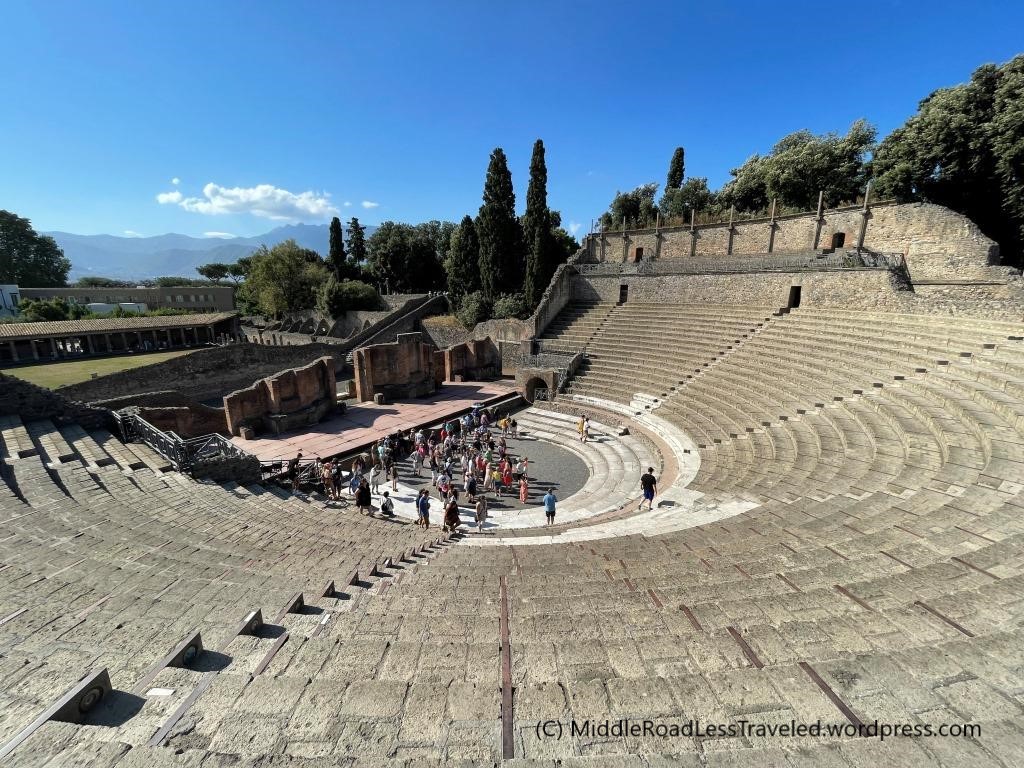
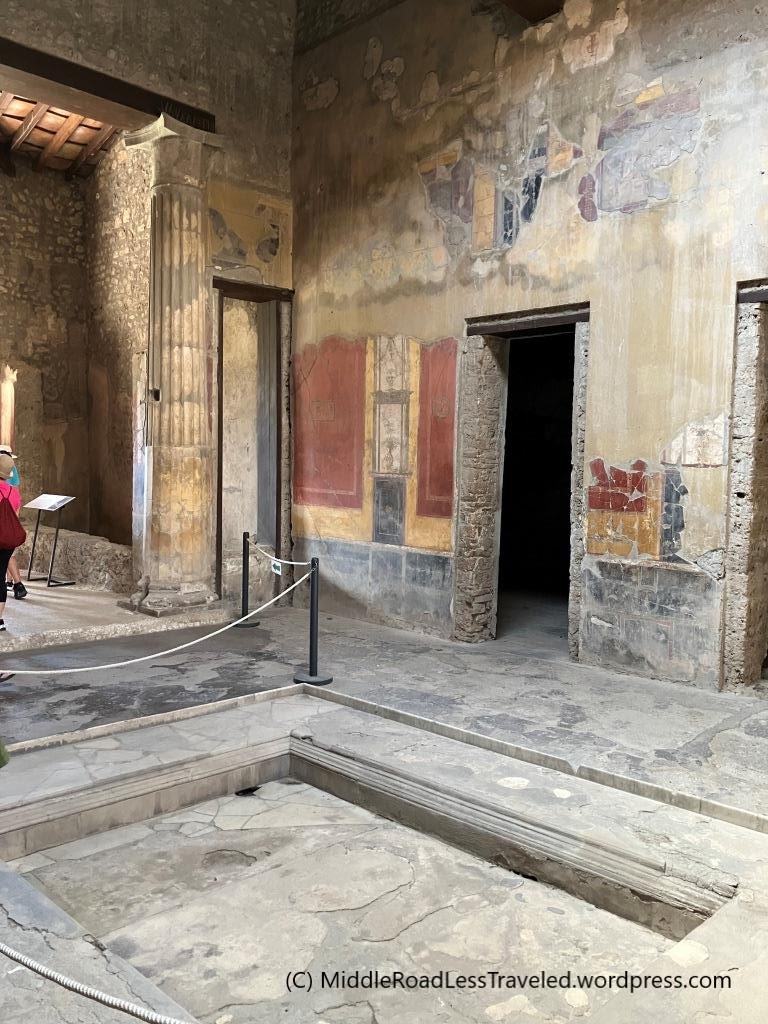
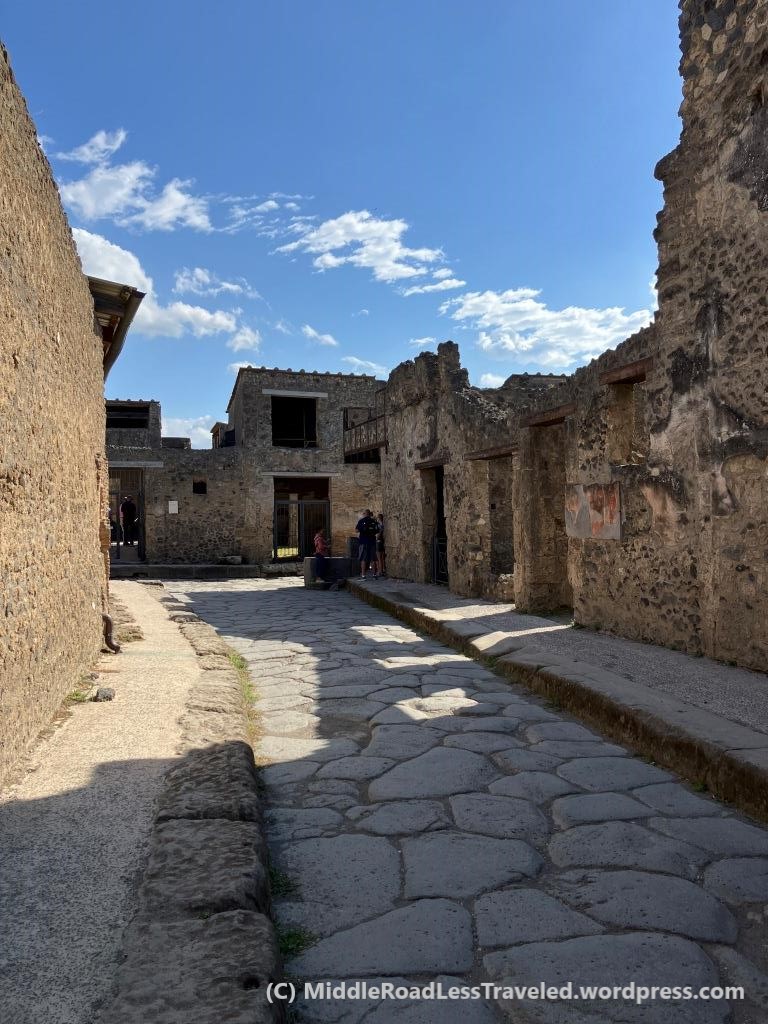
After Pompeii, the tour bus brought us and other passengers back to Salerno harbor. At that point we went exploring on our own! Since we had to return to the ship in a few hours, we chose to stay in Salerno vs. finding our way up the Amalfi coast. Walking outside of Salerno harbor, we quickly turned away from the main street that runs parallel with the harbor and walked among smaller, more intimate streets. These smaller streets were lined with various shops like restaurants, pharmacies, clothing, jewelry stores, etc. We walked several blocks northeast until we found a small, quiet restaurant for lunch. We had a great pizza bianca, drank Gazzosa (a soft drink like Sprite), and discussed where we wanted to explore next.
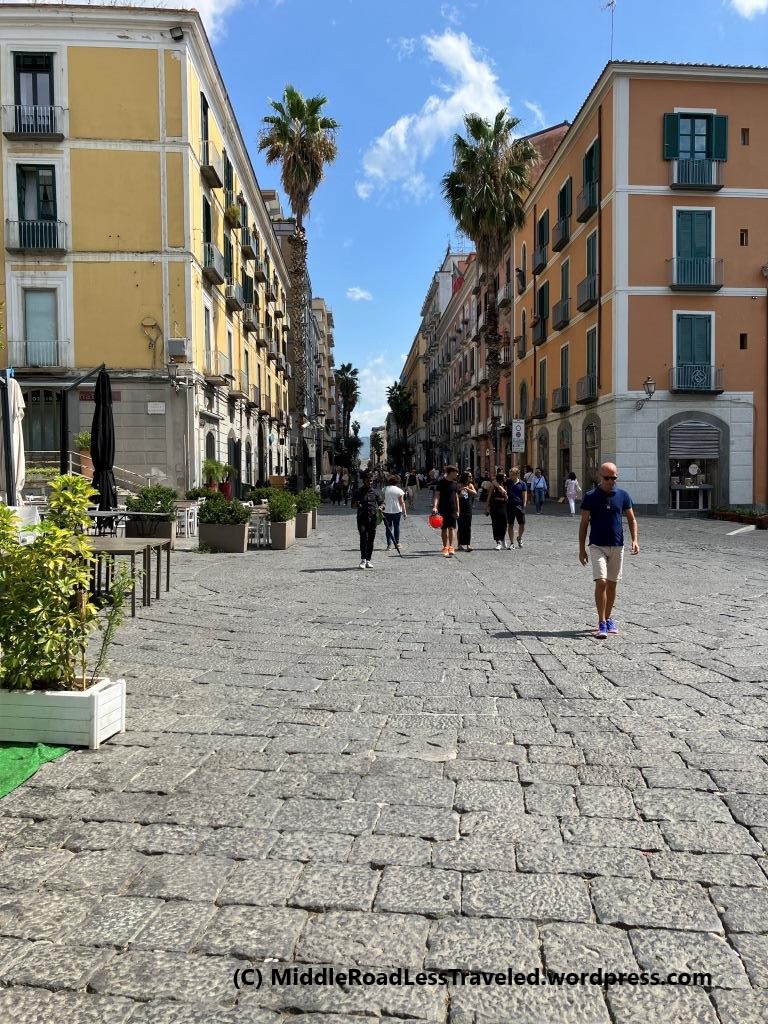
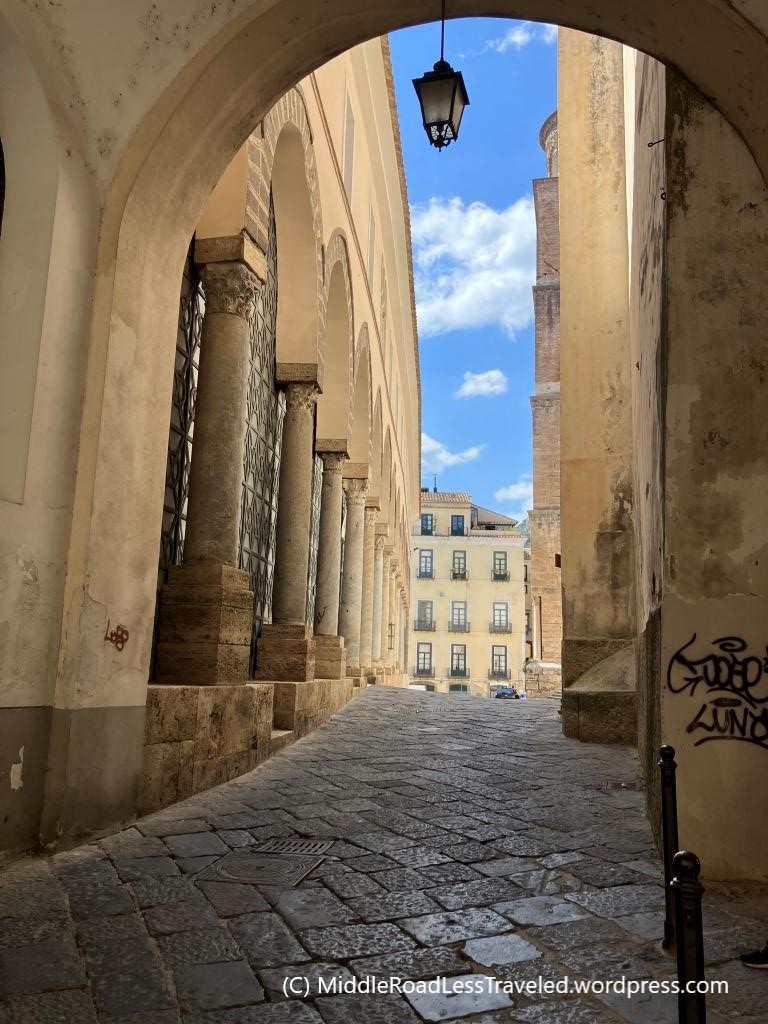
After lunch we visited a Roman aqueduct and several churches. On our way back to the ship we stumbled upon an active archeological dig named the church of San Pietro a Corte (St. Peter at Court). The door was open and we noticed a sign welcoming people to visit for free. There were a few original yet faded paintings on the wall and ceiling that were only partially visible due to their age. As with most ancient structures, layers were added over the years. The foundation pillars date to the 1st/2nd century AD.
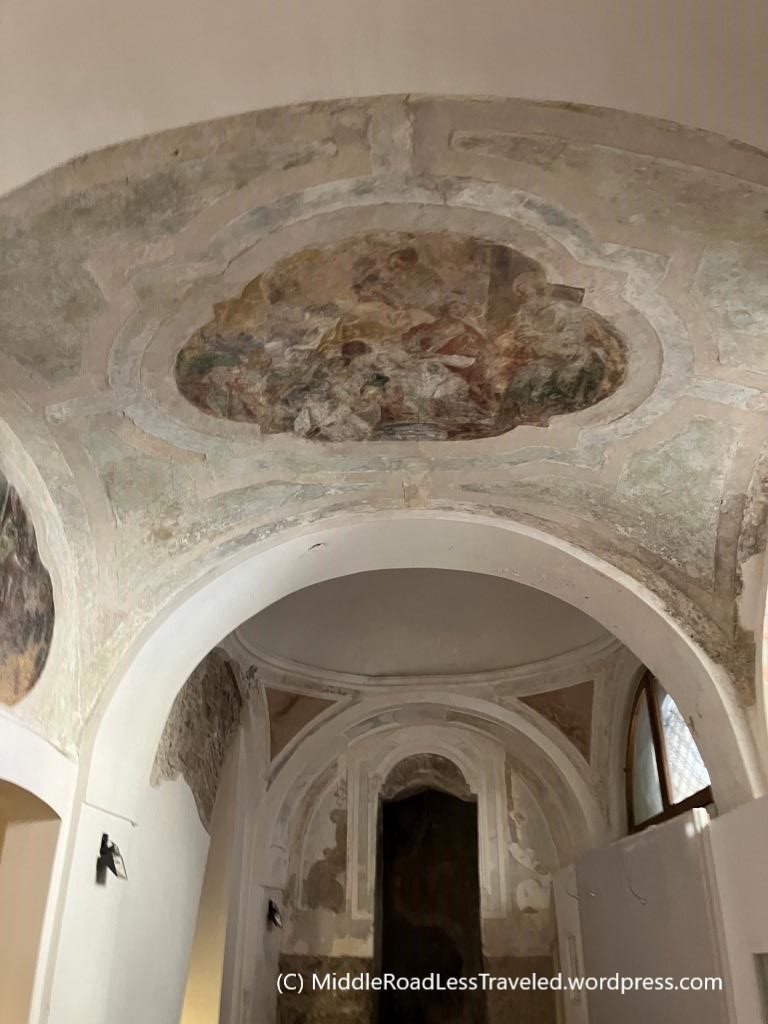
Cruise Day 2
Today, our boat docked in Siracusa, Sicily. Siracusa is located on the south eastern side of Sicily, farther south than the bottom of the Italian “boot”. We walked 6.5 miles or 15,100 steps that day.
The weather during the entire day when we visited was awful. It rained very hard with strong gusts of wind. Usually, Siracusa has clear blue water and colorful buildings shining in the sunlight much like the idealized photos of the Mediterranean you may have seen. The bad weather is one of many reasons we’ll return to Sicily.
We took a guided tour of Neapolis Archeological Park. Overall, the park was rather disappointing for a few reasons. During the tour we first visited the Latomia del Paradiso quarry that was used in the 3rd century BC. It had some natural features that were interesting. Next, we visited an amphitheater originally built by the Greeks in the 5th century BC. However, when the Spanish arrived in the 15th century they took a majority of the stone originally used for seating and used it for other projects. The amphitheater was re-built several decades ago using modern techniques. Essentially, most of the theater shows a modern outdoor amphitheater rather than an ancient Greek amphitheater which was not too interesting for us.
The only somewhat interesting exhibit was a small oval colosseum where gladiators fought during the Roman era. There are very few stones stacked vertically so its difficult to get an idea what this coliseum once looked like. The entrance way pictured below is one example that remains from the original structure. You can still see the outline of the foundation that forms an oval.
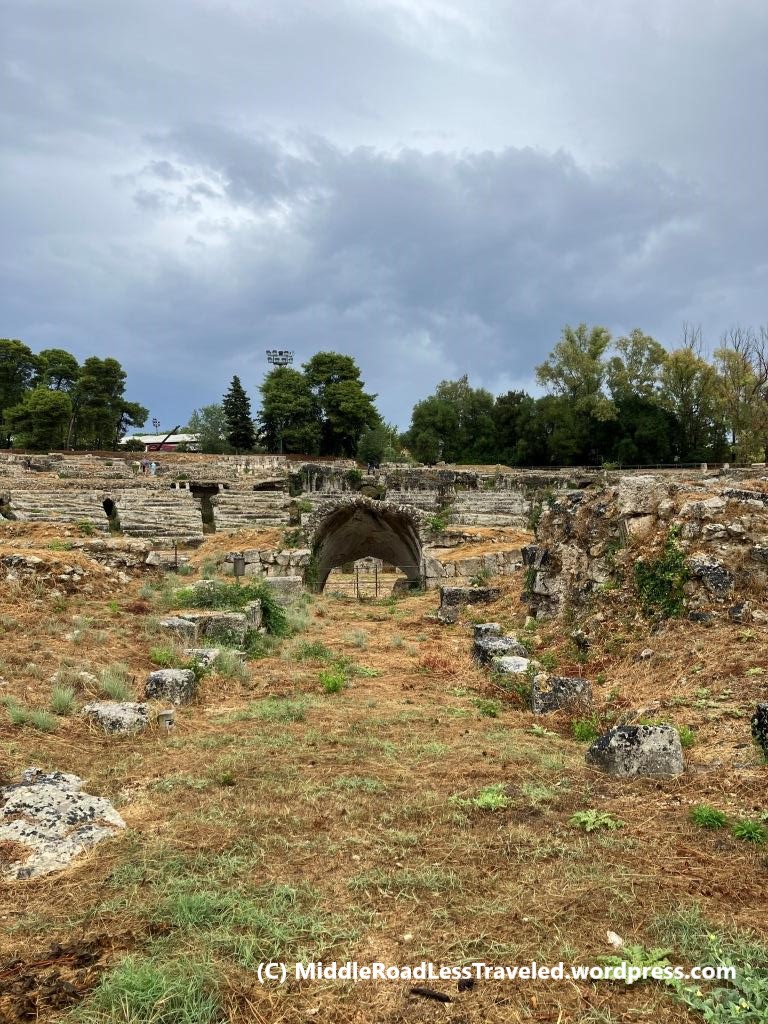
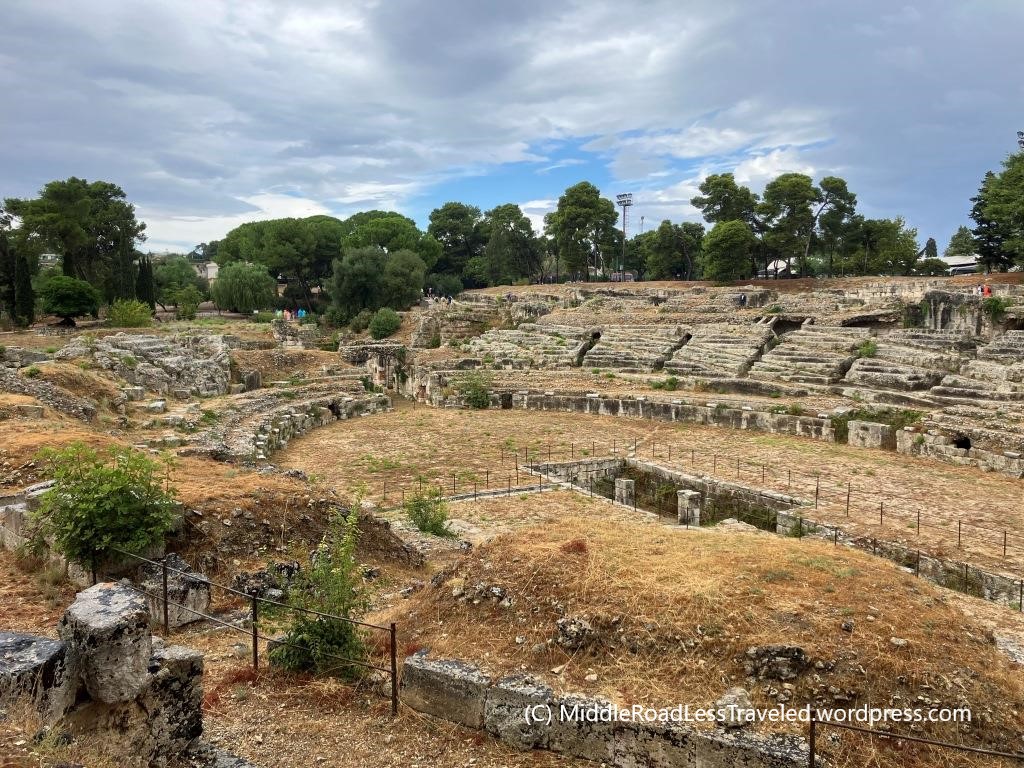
Our tour guide mentioned that the best Greek ruins on Sicily can be found in the Valley of the Monuments near Agrigento. This is yet another reason that we will return to Sicily.
After our tour, the bus drove us back to the boat. We decided, yet again, to wander, explore and create our own tour with the help of the “Maps” app on our iPhones. We walked across a short bridge to Ortygia/Ortigia island. We saw medieval and baroque buildings. We visited Arethusa Fountain/Spring, although it was more like a pond by the sea with trees and an ancient structure around it. We walked to Castello Maniace below.
We visited a few beautiful basilicas in the Palazzo Duomo below. We were free to quietly walk inside these basilicas except for one that was charging an entrance fee.
Lastly, we found an old Greek temple “Apollónion” dedicated to Apollo in the 6th century BC. The temple had two huge columns still standing with the outline of the foundation still visible.
After being drenched during our morning guided tour and periodically soaked with even more rain on our self-guided afternoon tour, we sloshed back to the boat, shoes squishing with every step, to change clothes and rest for dinner… and look forward to the huge variety of desserts that we rightfully deserved!
Cruise Day 3
Our next stop was one-day away in Santorini, Greece. This was a full day at sea so nothing exciting to write about.
Cruise Day 4
We arrived in Santorini, Greece. We visited the town of Oia and walked around Fira. Overall, we walked 7 miles or 17,387 steps that day.
The weather in Santorini was pleasant, 80 degrees with some wind. At about 6:45am we arrived and disembarked at the Santorini harbor via a tender boat service. We decided not to take a guided tour but instead explore the island mostly on our own. The only “guided” tour part was taking a coach bus from the harbor 30 minutes north to Oia (pronounced “eeh ah”) .
Oia is rather touristy, but fun. It was like the Greek equivalent of Lahaina, Maui. Essentially, a big cruise ship parks in the harbor and temporarily fills the street with thousands of tourists. Also, the town with gift shops, galleries, t-shirt stores and restaurants became inundated with tourists. [We were saddened to learn about the wildfires that destroyed Lahaina, Maui in August 2023. We visited Lahaina many times over the past 20 years and it’s difficult to see that it’s all gone.]
Oia has many little winding pathways and stairs that connect apartments, homes and little shops each with a clear view of the Mediterranean. We wandered and took photos. The cats seem to be well cared for by the citizens who live there. The local cats are fun to see walking on ledges, drinking water on window sills and happily sleeping in the shade. Scroll through some of the photos below.
After Oia, we returned to Fira via the coach bus. Fira is another touristy town with the same types of touristy stores, small hotels and apartments to rent. We walked through town, had gyros for lunch (of course), and prepared to walk north on the Fira to Oia walking trail. We walked probably 2.5 miles round trip from Fira to The Vasilicos, Caldera Heritage Suites and St. Nikolas Holy Convent. The walkway was safe, narrow and picturesque but even in just 80 degree heat it was hot since there’s very little shade.
At about 2pm we had enough of the sun and crowds so we decided to return to our ship. To reach the harbor from Fira there are two options; take the cable car or walk the stairs. The line for the cable car was about an hour long. Standing for an hour in the heat, nearly shoulder to shoulder with other tourists didn’t seem pleasant so we decided on option two – walk down the Karavolades Stairs.
The Karavolades Stairs are switch back stairs 1.2 miles long with a 600 foot descent (for us). It’s about 30 minutes to climb down walking at a brisk pace. The view includes the remnants of an ancient volcano and the Mediterranean sea. There are cafes and little shops at the top and bottom of the stairs where cold water and snacks can be purchased. Essentially, if you are in good shape the Karavolades Stairs are something you might try once in a lifetime just to say “I did it!”. And we did! (Just like we completed the drive to Hana, Maui… once…)
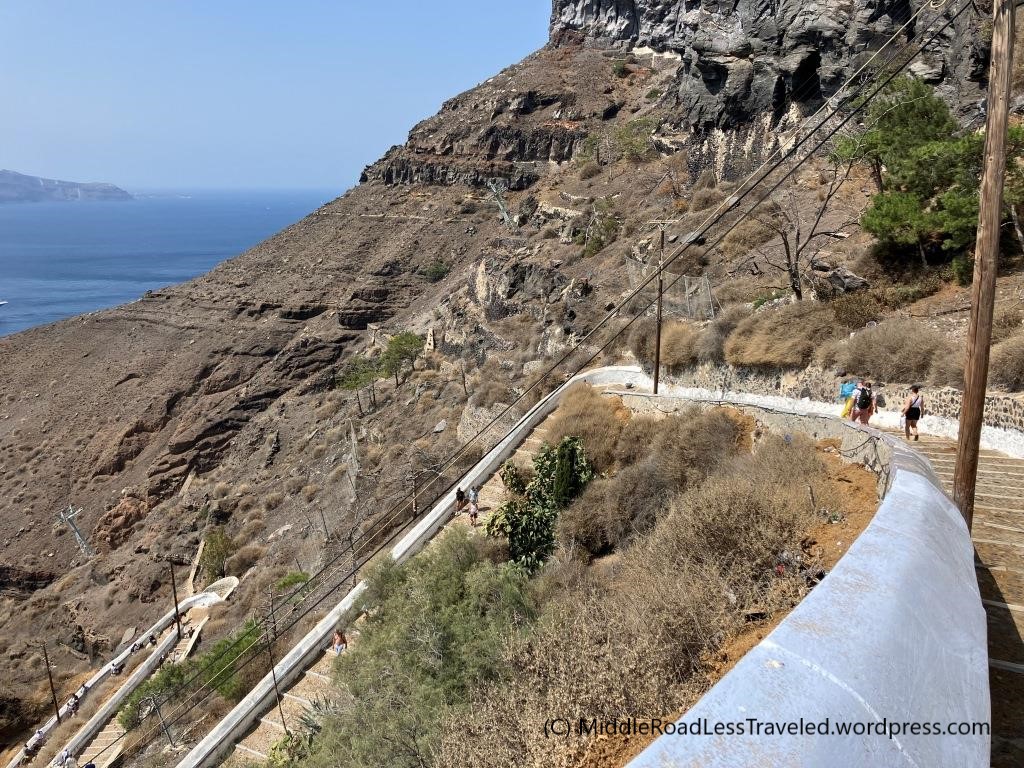
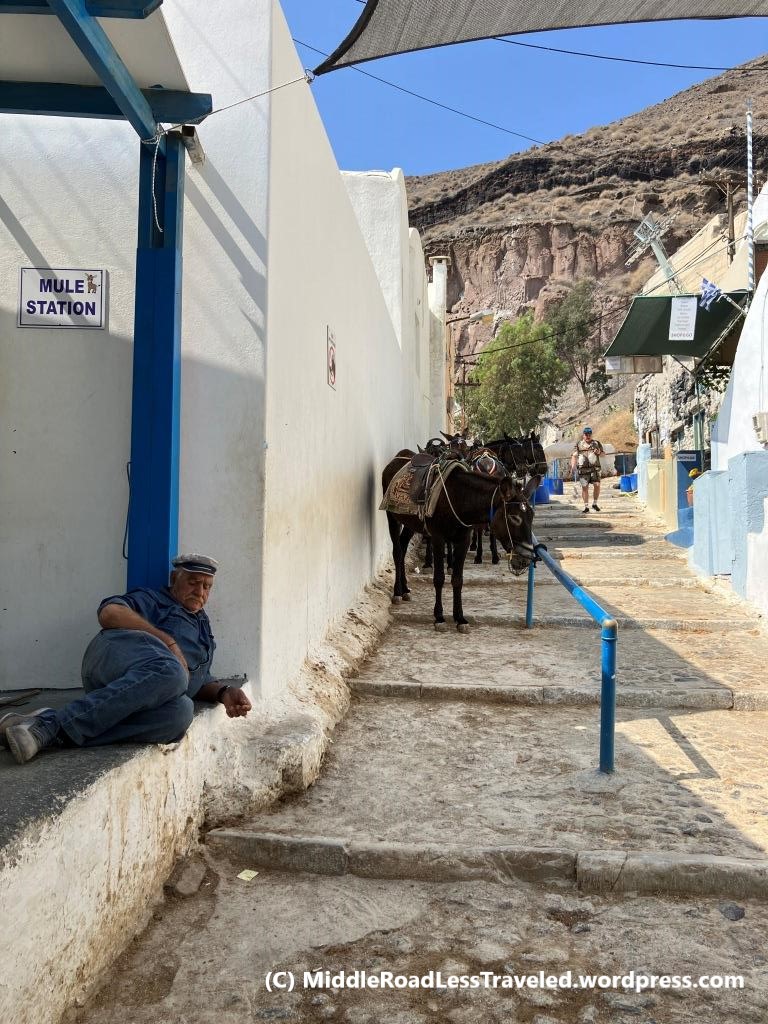
Cruise Day 5
We docked at Kusadasi, Turkey and visited the legendary city of Ephesus. Overall, we walked 6.2 miles or 15,615 steps that day.
A few months before our trip we booked a tour with a local tour company. At 8am at the port exit point we met our tour guide. We learned that we were the only people in the tour, so we had a private tour guide!
We boarded a nice, air conditioned, cruiser van with our guide and headed about 30 minutes to the Ephesus archeological site. I know I’ve used the word “amazing” a lot on this trip, but Ephesus is truly amazing. Ephesus dates back to about 7,000 BC. If you remember in the New Testament “Paul’s letter to the Ephesians”, Ephesus is the audience he, or one of his disciples, was writing to sometime before 90 AD. Ephesus was conquered by the Greeks, Romans, Goths, etc. and rebuilt and extended until its gradual decline in the 5th century AD.
We arrived at the Ephesus Archeological site early when only a few other tour buses were present, thus the park wasn’t crowded. In summary, we walked through the small amphitheater, public baths, the Celcus/Celsus library, the large amphitheater, the marketplace, walked along the original marble sidewalks, stone roads and saw a few other buildings along the way. What is incomprehensible is that archeologists have been excavating Ephesus for 150 years but have only uncovered ~20% of the entire site. At this rate it would take 600 years to completely uncover Ephesus. We were able to walk through or get up close to many original buildings. In other archeological sites we’ve visited on this and other trips they often restrict access and keep tourists (and those who ruin monuments with graffiti) away from the monuments. However, at Ephesus you can get up close to the buildings and monuments.

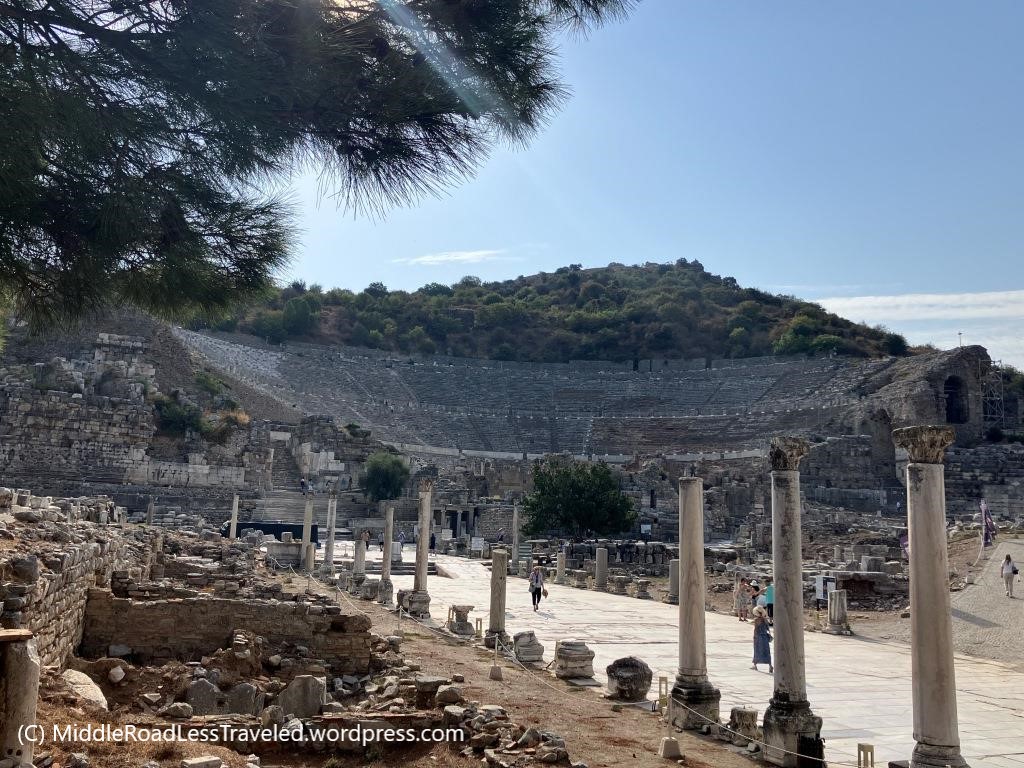
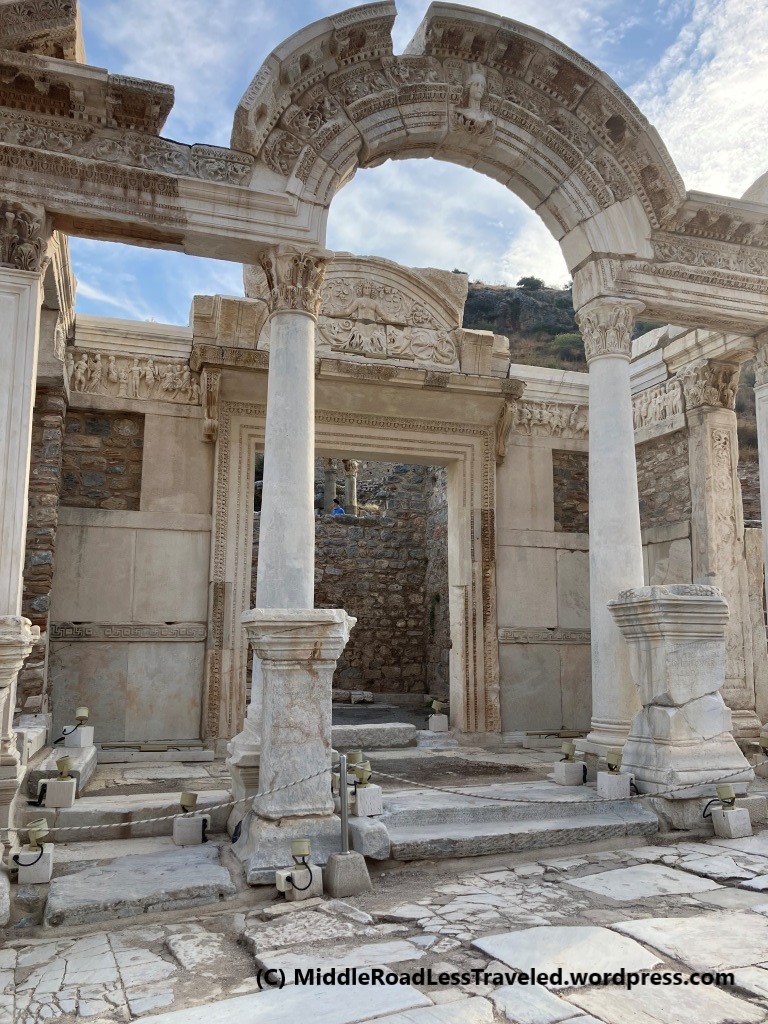
The highlight was the Ephesus Celcus Library. I’ve seen pictures of this library in various ancient history books and thought it was wonderful. Actually seeing it up close and walking through the entrance archways was unforgettable. The original patterns etched in stone are still very fresh even though they date from the 2nd century AD. I added my best pictures below.
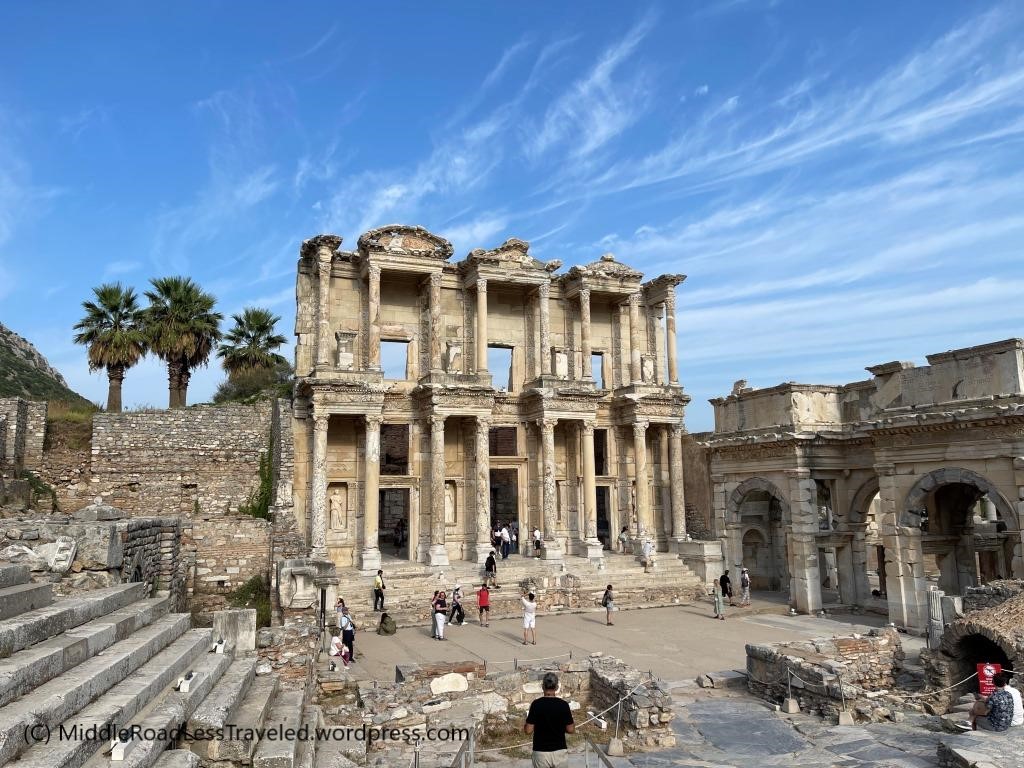
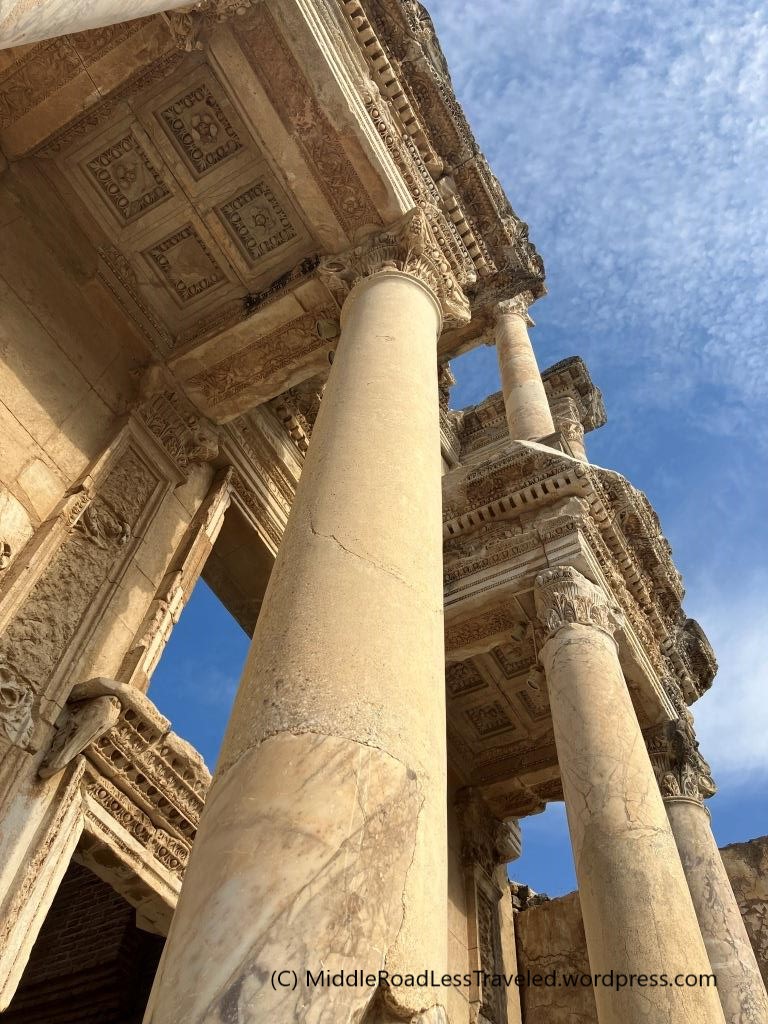
One unexpected highlight of our tour were the Ephesus cats. We love cats so I needed a reason to add some cat photos. These cats are short-haired, tabby cats with different colors and patterns and are found everywhere in the park. We saw a fluffy cat perched high on an ancient column about five feet off the ground. This cat was patient and looked forward to friendly tourists petting (aka worshiping) him.
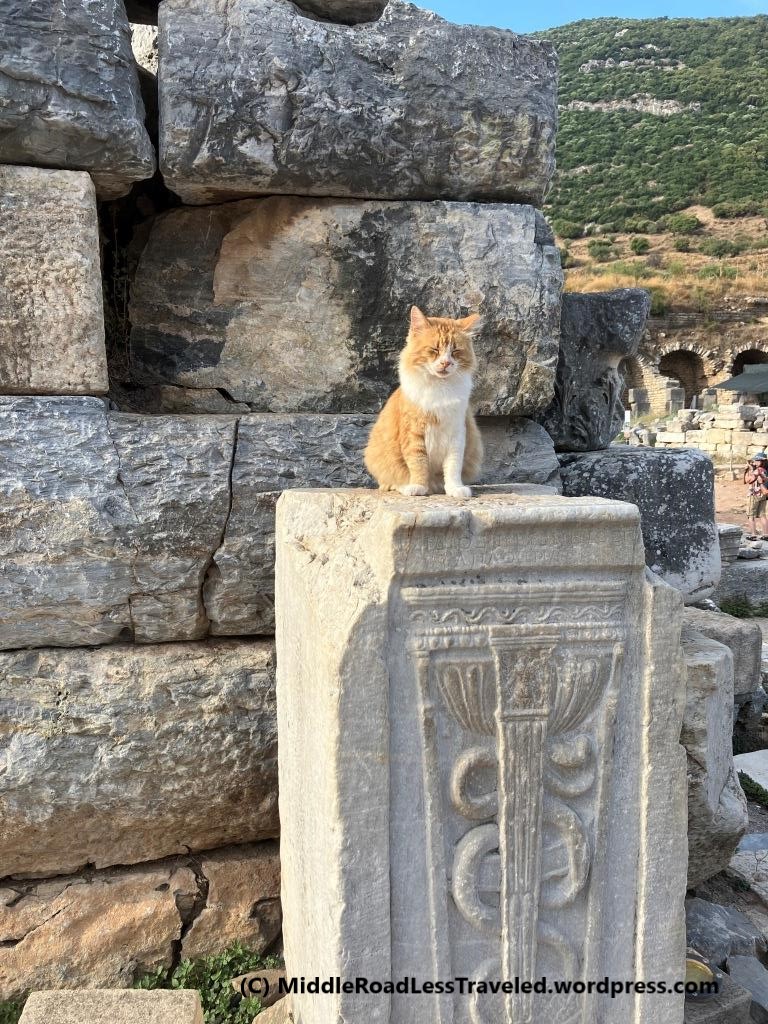
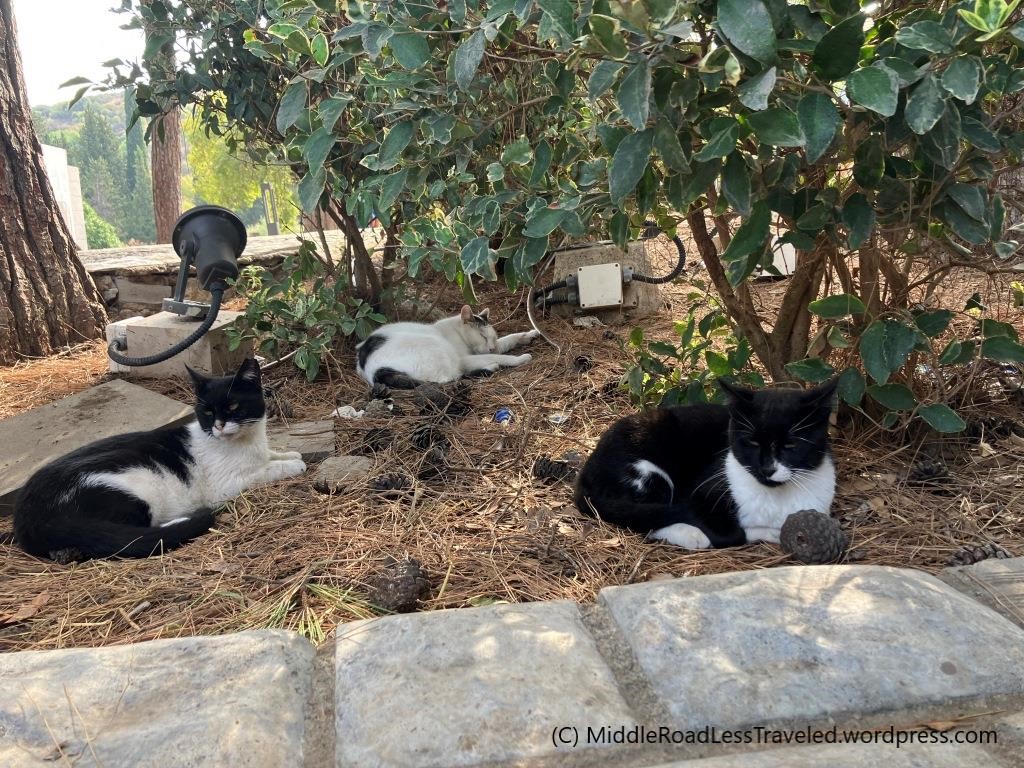
Afterwards, our tour guide dropped us off at our port. We had lunch and set out to explore Kusadasi Castle on Pigeon Island. Kusadasi Castle was build in the 14th century and expanded through the 18th century. The outer perimeter of the castle is free to browse around. The only part that was closed was the castle itself. You can see the castle in the picture below. The statue on the right is Barbaros, a 16th century Turkish Mariner.
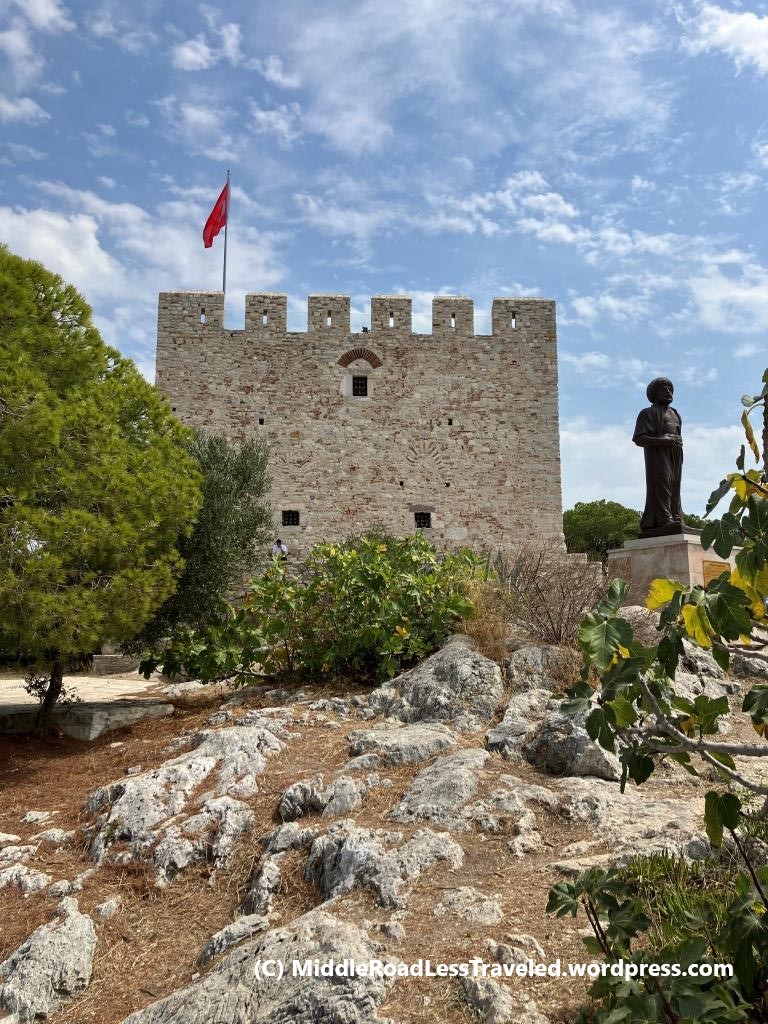
Lastly, we explored the old Kusadasi town center. It’s mainly shops, restaurants and a few mosques. Some shops proudly advertise and sell “genuine fake” branded merchandise like watches, shoes, clothing, and other items.
Even though it was only 86 degrees Fahrenheit it was very humid when we visited. At about 3pm we ran out of energy, went back to the boat and treated ourselves to soft-serve ice cream.
Tomorrow we will land in Mykonos, Greece. I’m looking forward to seeing how Mykonos compares to Santorini. Mykonos will be our last stop before we disembark in Athens, Greece in two days.
Cruise Day 6
In Mykonos we were happy to explore on our own without a guide. Overall, we walked 5.3 miles or 12,300 steps that day.
At about 7am our ship docked at the Mykonos cruise ship terminal at Tourios. We paid to take the SeaBus water taxi to Mykonos Town (or “Chora” the Greek word for town). Round trip SeaBus tickets for one adult cost us four euros.
Once in Mykonos Town we explored the streets. The main goal, much like Santorini, is simply to wander and experience such a warm, beautiful place. It’s difficult to get lost since the ocean is on one side, six historic windmills (Kato Mili) on the other and residential homes are up-hill.
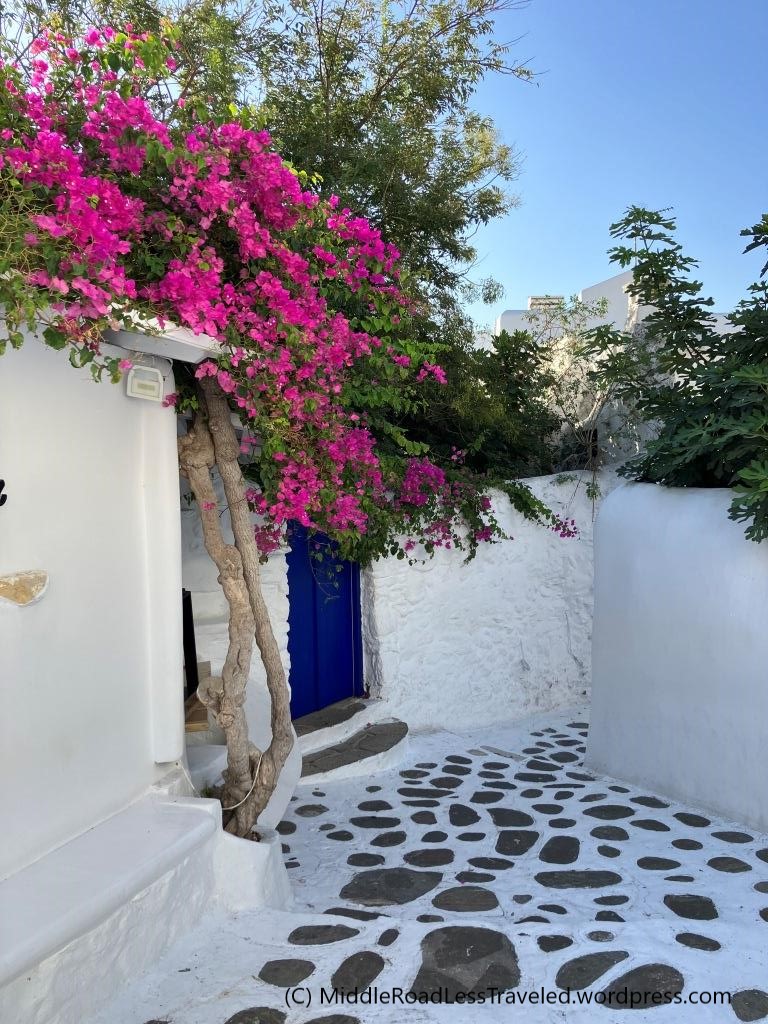
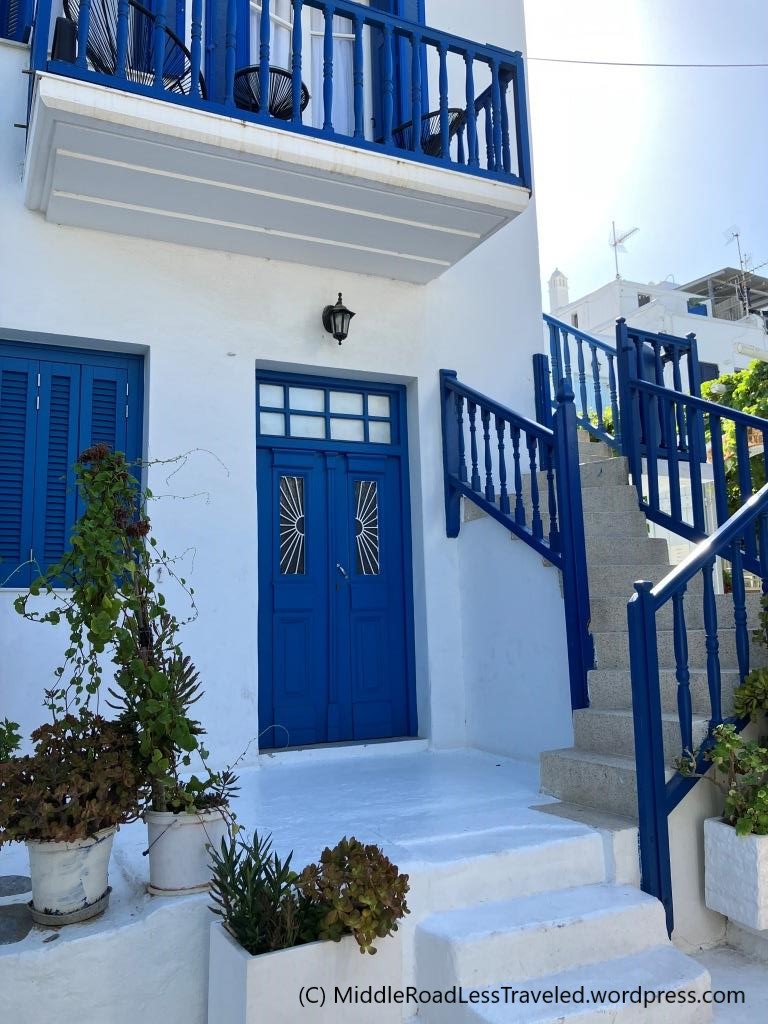
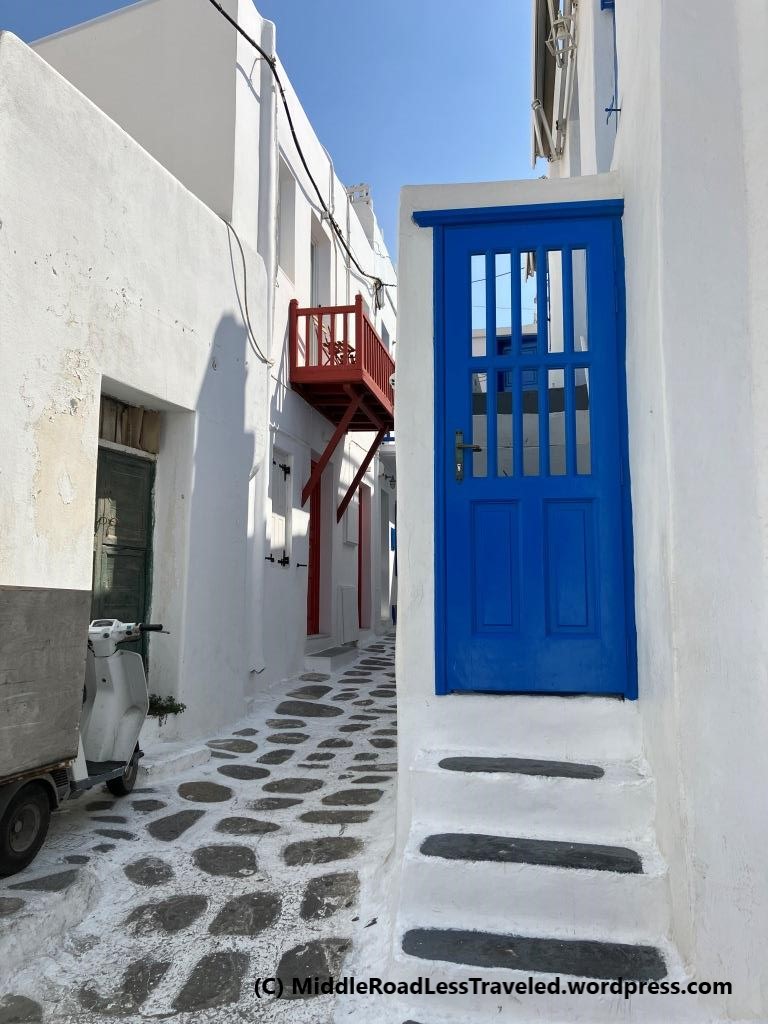
We walked through the Little Venice Quarter. It’s called Little Venice since small, colorful two story homes sit on the waters edge. Some of the homes have been converted to restaurants and cafes with the ocean at your feet. I noticed one restaurant employee had a comfortable seat inside the restaurant casting a line into the ocean with the hope of catching something. He used a piece of day old bread as bait, but I’m not sure if any fish were interested. Next, we walked to the six historic wind mills named Kato Mili which are located on top of a small hill very close to Little Venice (right photo below).
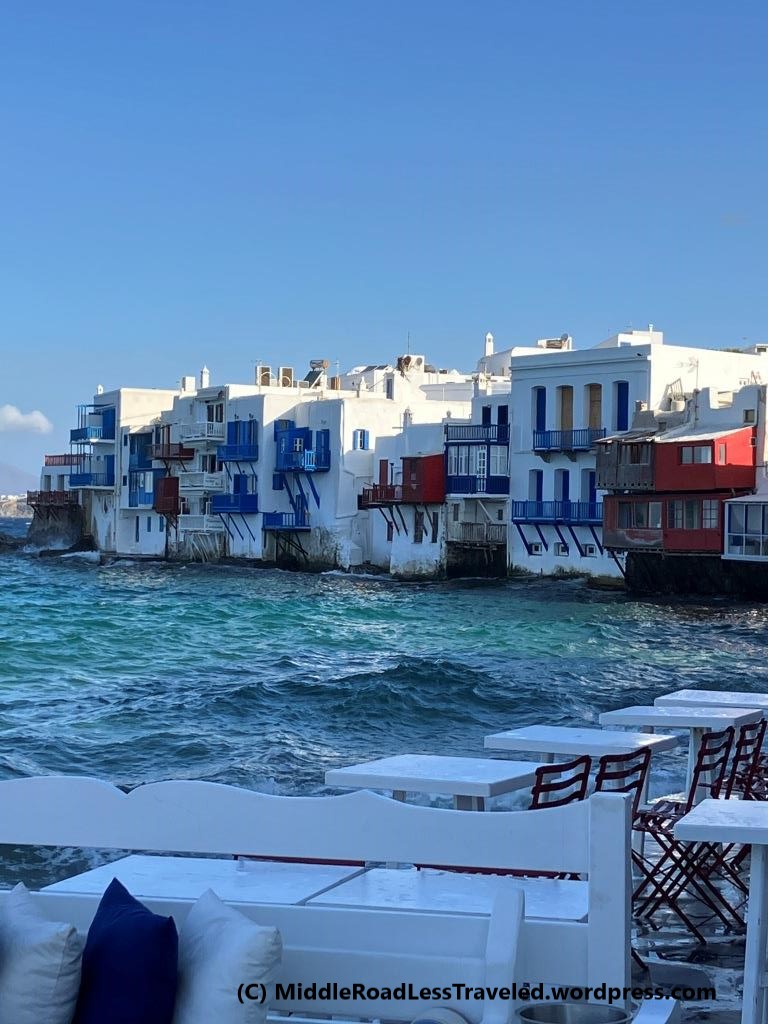
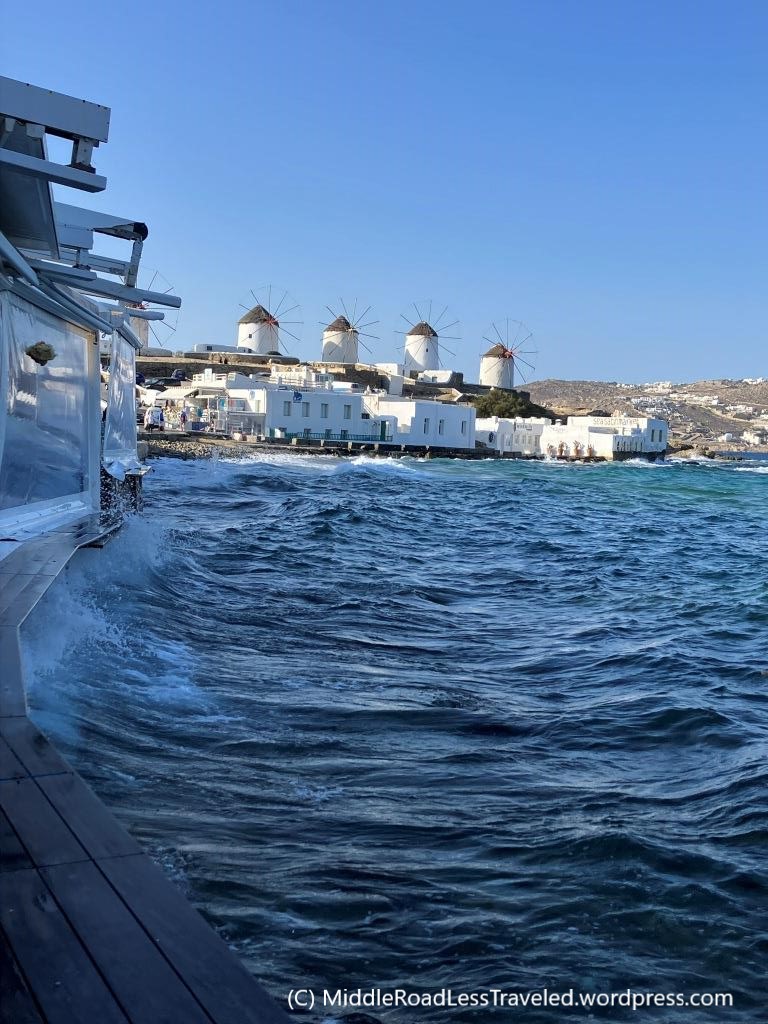
After about two hours wandering the streets, taking photos we found a series of narrow streets that led uphill. We eventually arrived at an old windmill resting on the edge of a hill several hundred feet above sea level. On the edge of the windmill, we took in sweeping views where Mykonos Town, Little Venice and calm but restless ocean waves met.
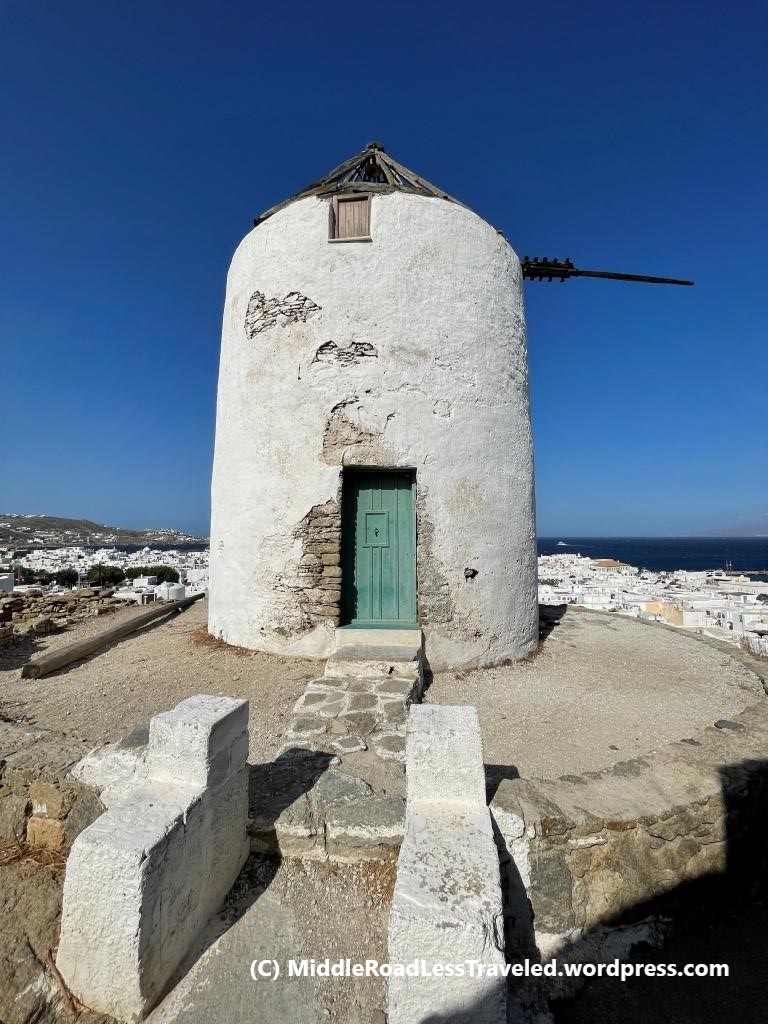
During our wandering we saw Mykonos Castle and Paraportiani Church (aka, the Church of Our Lady). The castle was built in the 16th or 17th century. The church is apparently one of the most photographed churches in Greece.
After feeling like we had become very familiar with Mykonos Town and had taken plenty of pictures, we wanted to venture further and see more of the island. We bought bus tickets to visit Ano Mera Town. Ano Mera is a small town about 20 minutes east of Mykonos Town. The bus departs from Old Port station. Round trip tickets for one adult were 3.50 euros. The bus was a nice, comfortable, air conditioned coach.
The landscape outside Mykonos Town reminded me of the American southwest, like parts of Arizona, Utah, Nevada – brown vegetation, dry, rocky, hilly with sparse, although white, houses built on the hill-sides. The highest peak on the island is 1,119 feet.
Our bus driver dropped us and several others off at at unmarked bus stop in Ano Mera (their bus stops aren’t clearly marked).
Ano Mera was built around a 16th century monastery named Panagia Tourliani. It costs 2 euros per person to enter the monastery. Inside the monastery there is a tall bell tower, Byzantine relics, and other interesting features. Next to the monastery are a series of nice and reasonably priced restaurants. We sat in the shade of an open air restaurant with several other restaurant-goers and had a nice lunch. Afterwards, we walked around the main street near the monastery.
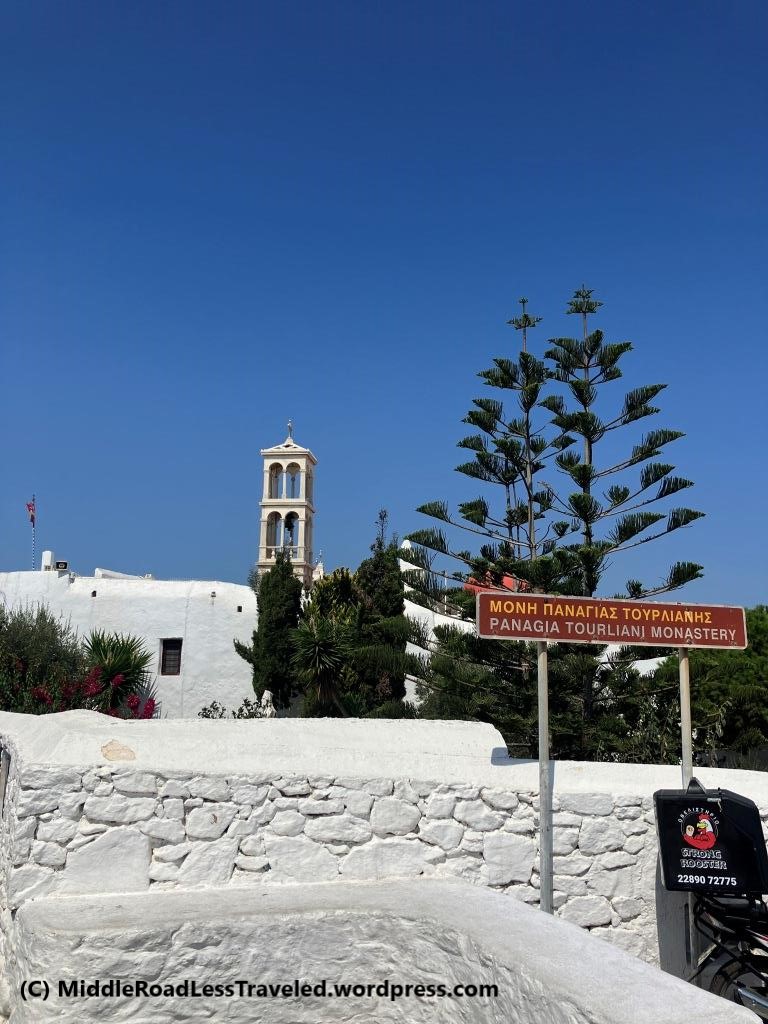
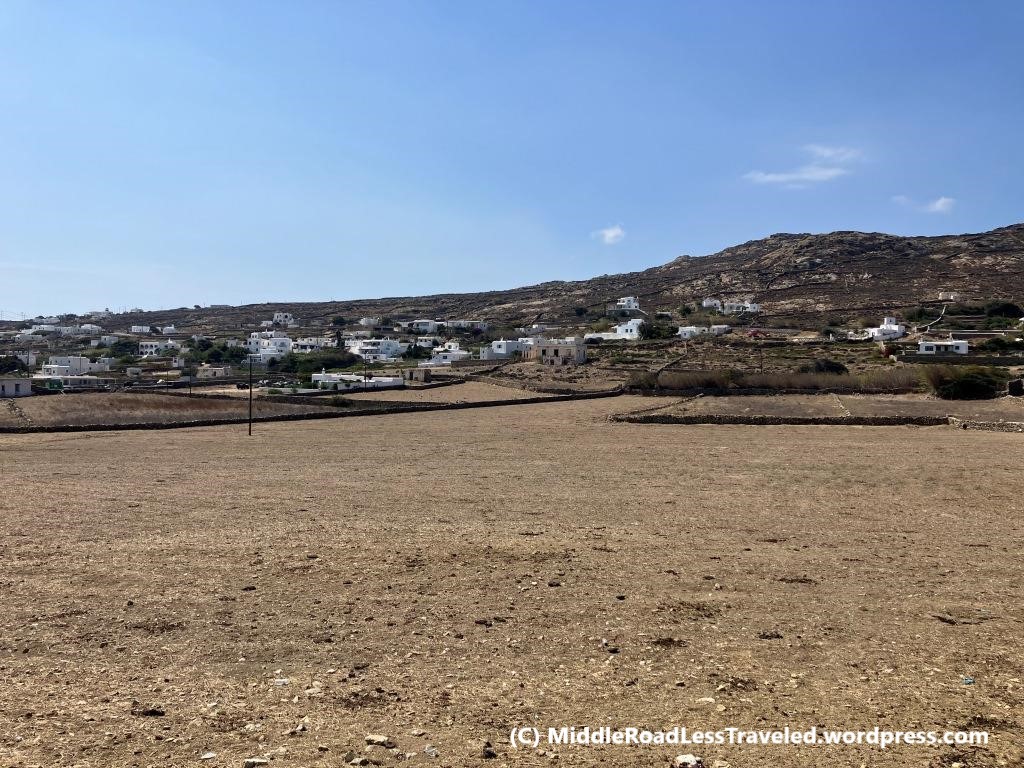
We took the bus from Ano Mera back to the Old Port station and eventually made it back to our big boat.
Tomorrow our cruise will end in Athens, Greece. We will spend two nights in Athens part 3 before heading home. Part 1 of our trip describes our stay in Rome as part of this overall trip.

